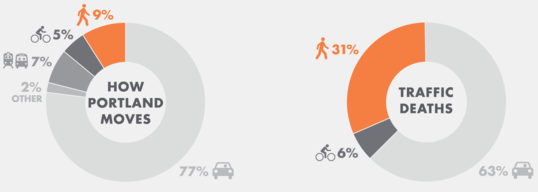|
(Oct. 29, 2019) The end of daylight saving time at 2 a.m. on Sunday, Nov. 3 means more people will be traveling in dark conditions during their commute home. This increases the risk of collisions at the time of day when crashes are already most likely to occur.
Portland crashes peak in frequency between 5 and 6 p.m., and research shows that dark conditions introduce a 30 percent increase in the risk of injury crashes in urban areas relative to daylight conditions.
Pedestrians in Portland are at particular risk. They already make up a disproportionate share of Portland traffic deaths; a citywide survey found that about 9 percent of trips in Portland are made by foot or mobility device, yet pedestrians make up about a third of Portland’s traffic deaths (see graphs below).
 Pedestrians are overrepresented in Portland's traffic deaths, making up nine percent of trips yet 31 percent of traffic deaths. (2004-13 ODOT crash data; 2015 City of Portland Community Survey)
Portland data also show that more pedestrians are involved in crashes in the fall and winter months (see graph below). This is the opposite seasonal trend as crashes involving people biking and driving, which typically peak in summer months and dip in fall and winter.
At the national level, the proportion of pedestrian deaths occurring in dark conditions has been increasing, from 68 percent in 2007 to nearly 75 percent in 2016.
Earlier this year Oregon lawmakers passed a bill that would make daylight saving time permanent, potentially benefiting traffic safety. Before the law can take effect, California must still pass a similar bill, and then Congress must agree to the change.
Street lighting can help, but improvements are needed
A recent U.K. study found that pedestrians at crossings are 1.7 times more likely to be hit by a person driving at night, compared with during the day.
The study notes that many crossings had street lighting present but questions “whether the lighting at crossings is adequate and sufficiently improves its conspicuity and the visibility of any pedestrians waiting at or walking on it.”
These findings align with Portland data, which indicate that streetlights are already present in most pedestrian crashes that occur in dark conditions (see dark blue color in the chart below).
 People driving collide with pedestrians more frequently in fall and winter; many crashes occur where street lights are present, indicating that lighting may need to be improved. (Data: PedPDX Pedestrian Master Plan)
East Portland streets are especially deficient in lighting, with many wide streets such as NE Halsey Street having lighting only on one side, resulting in patchy illumination.
The Portland Bureau of Transportation is working to improve lighting in several ways:
- PBOT recently revised its lighting guidelines to include information specific to crossings, sidewalks, and other pedestrian spaces. PBOT is using the new guidelines in projects citywide.
- The newly adopted PedPDX Pedestrian Master Plan calls for PBOT to “strategically improve” street lighting conditions for pedestrians, including on High Crash Network streets.
- Significant lighting improvements are on the way for SE Division and Stark streets east of 82nd Avenue in 2020 at intersections and midblock crossings. Earlier this year we added lighting on SE Division Street at crossings near 87th and 127th avenues.
As PBOT works to improve street lighting, please travel carefully in dark conditions
-
Take it slow, especially when making a left turn. Safe speeds help you see other people, give you more time to stop, and reduce the severity of crashes when they occur. Left turns are one of the trickiest maneuvers people make when driving.
-
Maintain your vehicle. Clean windshields, properly aligned headlights, and good-condition wipers help you see other people when driving.
-
Use lights, however you travel. Make it a habit to turn on headlights every time you drive. Flashlights, bike lights, and reflective gear can make you more visible when outside of motor vehicles. PBOT is providing free reflective stickers at events through February.
Thank you for supporting Portland’s Vision Zero work to eliminate traffic deaths and serious injuries.
To learn more about efforts by the City of Portland and regional partners to eliminate traffic fatalities and serious injuries, see PBOT's Vision Zero website
Email: visionzero@portlandoregon.gov
The Portland Bureau of Transportation (PBOT) is the steward of the City’s transportation system, and a community partner in shaping a livable city. We plan, build, manage and maintain an effective and safe transportation system that provides access and mobility.
portlandoregon.gov/transportation
|